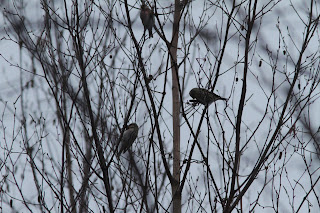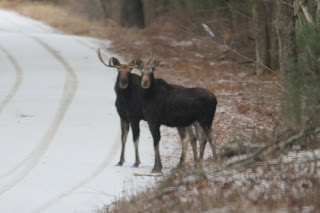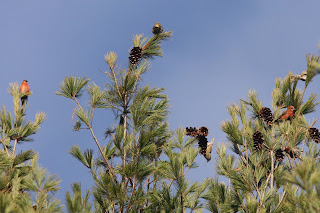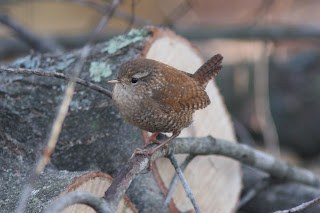 Cape May Warbler, Magee Marsh, May 14, 2010
Cape May Warbler, Magee Marsh, May 14, 2010 Gray Jay, Pittsburg, NH, June 25, 2010
Gray Jay, Pittsburg, NH, June 25, 2010  Common Loon, Quabbin, July 12, 2010
Common Loon, Quabbin, July 12, 2010 Harris Hawk, Sweetwater Wetlands, AZ, March 29, 2010
Harris Hawk, Sweetwater Wetlands, AZ, March 29, 2010 Broad-billed Hummingbird, Madera Canyon, March 31, 2010
Broad-billed Hummingbird, Madera Canyon, March 31, 2010  Short-eared Owl, Honey Pot-Hadley, MA, October 11, 2010
Short-eared Owl, Honey Pot-Hadley, MA, October 11, 2010 Anna's Hummingbird, Red Rock SP, AZ, October 30 , 2010
Anna's Hummingbird, Red Rock SP, AZ, October 30 , 2010 As 2010 comes to a rapid close I want to do a quick review of the year for me. The year had its good times and bad. I'll start with the good and go through the numbers for the year. I took several trips out of the area including a late March/early April trip to southeast Arizona, a few day trip out to Ohio to Magee Marsh, a long weekend trip to far northern New Hampshire in late June, a late October trip to central and northern Arizona, as well as a trip to Cape Cod
I managed to add 28 species to my overall life list with most coming from the two trips out to Arizona. I found a total of 307 species over the course of the year. I broke 100 species in four states and broke 200 (210) in Massachusetts. I continued to use eBird to track my sightings and entered just shy of 1400 reports for the year bringing my total reports to eBird up over 6000. It is a nice way to keep track of sightings as well as add scientific value to my many trips throughout the year. I made many, many trips around the local area with a large concentration at areas within Quabbin as I completed the fourth year of the Massachusetts Breeding Bird Atlas. The Breeding Bird Atlas had many highlights for me including breeding Red Crossbills at Quabbin, numerous examples of breeding warblers as well as various migrant species moving through during both spring and fall. I also took part in some additional bird breeding work with Quabbin biologists including loon surveys and scrub land research. I also managed to add species to my yard list including a Kentucky Warbler moving through with a mixed species flock in spring. I hope you enjoy some of the many, many photos taken this year.
Now for the bad parts of 2010. I lost my best buddy in March when our dog Kody died. He frequently joined me on my walks and would patiently wait as I checked out the bird life. He is missed and always will be.
 Kody and all his toys
Kody and all his toysI also lost a good birding friend Chris Ellison during the summer when he died suddenly and far too young. I will miss meeting up with Chris before club trips and checking out the area before others had arrived. He truly loved the outdoors and all the creatures who lived there and we both shared a love of Quabbin. I will end the year end wrap up with a well written report from Chris from a visit he had to Winimussett Wildlife Management Area on an August day and evening. This location is where his ashes were spread and a place he would be happy to be spending eternity in.
Winimussett Wildlife Management Area, New Braintree
many birds eagerly taking advantage of calmer conditions. Cavity nesters were quick
to take advantage of the carnage wrought by the storm activity, eagerly exploring
the shattered tree trunks and battered branches for hapless insect larvae. A
stunning Great Egret parsed the shallows visible behind the Massachusetts Division
of Fisheries and Wildlife barn along Mackay Road, soft breezes tousling the
statuesque wader’s feathers, a magnet for the fleeting rays of a short-lived
sunrise. A loose flock of Wood Ducks fed and preened vigorously, with juvenile
males providing a wonderfully engaging study of plumage development. Through
binoculars, their motley array of nascent head feathers left the impression of a
handful of battered Christmas ornaments strewn along the distant waterline.
Bringing a scope to bear upon a quartet of Northern Flickers spread along a half
mile of broken tree line supplied much amusement. The rotund woodpeckers hammered
breakage points with wild abandon, one bird generating a nearly continuous stream of
dark bark fragments as it gorged on readily available provender. Oblivious to the
intensity of its efforts, the bark beneath its feet began to detach rapidly, the
bird being driven into the air as its perch became too precarious to manage!
Traipsing along the border of the massive cornfield accessible from the pull-off at
the bottom of Mackay Road coaxed an American Woodcock aloft, the bird streaking away
like a disembodied leaf, whistling through the air and instantly vanishing into the
weedy turf beyond. Gray Catbirds bawled incessantly from the depths of the willow
grove abutting the water. Distant whistled triplets arced steadily over the marsh.
An evenly checkered graphite-gray back and wings, followed by gleaming white
uppertail coverts, plunked down on one of the few open patches of mud to be found
along the waterlogged border. A stately upturned bill swiveled to and fro. Shining
black eyes darted over the landscape, finding it free of any sign of danger. The
Greater Yellowlegs eased into the shallows, its travels taking it past a loafing
pair of Green-winged Teal. A glowing ruby ember hung suspended above the rippling
water, hurtling suddenly towards its edge. After
examining the elegant sandpiper and dozing teal, it rocketed away towards a
bedraggled maple sapling. The Ruby-throated Hummingbird alighted upon its tip,
leaning slightly forward, calmly studying the water in an effort to distinguish
other occupants of the secluded eddy. Finding none, it bolted from its perch,
darting toward a sumptuous array of Orange Jewelweed. As enchanted by the lush
flowers as the tiny bird, I followed its hyperactive shape to the edge of the
vibrant blossoms. Briefly perceiving me as a potential threat, the feisty bird
abruptly turned and hovered at eye level a mere six feet away, boldly asserting its
dominion over the vivid orange flowers. Its whirring silhouette unflinchingly
mimicked my every move, and I marveled at its tenacity. Happy to leave the bird to
its reward, I slogged well around it into the thick of the soggy waist high grass,
seeking out an unobtrusive observation point from which to examine the distant
water. I erected a scope and settled into a portable seat, opting to glass the
swallows hurtling through the sultry air. A furtive movement appeared in the
corner of my non-viewing eye, and I ceased gazing at the swallows to determine its
source. The tip of a slender wedge of glistening muck yielded a pudgy shape
surrounded by dancing ripples. It inched further into the sun, revealing a back
streaked with bold tawny stripes. The bird pivoted sharply to the right, an
arresting bill snapping into view. As I refined my focus upon the bird’s head, its
bulbous black eyes came into clear view, conveying genuine fear. A prodigious
shadow swept over the water, propelling the stout blob aloft and away from me on a
zig-zagging course, its squat orange tail seemingly buoyed by a hoarse chant of
SCRAPE! SCRAPE! SCRAPE! As the Red-tailed Hawk doubled back upon a promising
thermal, the Wilson’s Snipe plunged into a thoroughly inaccessible portion of the
adjacent swamp, invisible once more. The hawk’s head swiveled slightly, perhaps
taken in by the sudden distraction below. Soon reabsorbed in its study of the
landscape, the brawny raptor circled rapidly out of sight. As sweat stung my eyes,
I decided to return later in the day when temperatures would cool, and a
potentially awe-inspiring annual migration pattern would unfold.
I arrived at the Winimussett Wildlife Management Area parking lot at roughly 5:30
and promptly snapped a scope into place, faint snatches of tiny raindrops pelting
the windows of my car. The shifting cloudscape conveyed a distinctly menacing air,
varying hues of metallic gray and garish orange set in motion by a cool, strangely
pleasant breeze. The musical, percussive slosh of an American Bittern’s call hung
over the billowing tall grass. After some twenty-five minutes of canvassing empty
skies, my ears and eyes were inevitably drawn to the intermittent snatches of
passerine song emanating from the surrounding shrubs and the spectacular array of
Wood Ducks coursing through the shimmering waters of the marsh. The tumbling notes
of an Indigo Bunting’s song cascaded relentlessly from the spare branches of a
nearby maple, and I was happy to lock my scope onto its searing blue outline, having
despaired of detecting any significant nighthawk activity.
A sudden breeze swept the bunting into the taller trees across the road. As it
alighted in the crown of a dying oak, my heart leapt. Though somewhat out of
focus, unmistakably limber wings tipped with luminous white patches knifed through
the gloom. I switched to binocular viewing to discern if it was a lone bird or one
of many. The bird stood out in stark relief against the sky, completely isolated.
I followed it from horizon to horizon, and acquired the bird in the scope when it
became too distant to study easily with binoculars. It swerved into a glowing band
of light swelling along the southern horizon, and I savored the more accommodating
view. I craned my neck upward, taking in the snatches of birds pushing overhead
and joining their comrades coursing past the radiant strip of clouds that first
grabbed my interest. I was delighted to find other nighthawks accumulating slowly
in this brightly illuminated patch of sky, swooping and diving in
every direction after what must have been an enormous hatch of insects. Their
numbers continued to swell, the flock pushing slowly west over the adjacent farm
fields, merging with additional birds directly over the intersection of Hardwick
and West Roads. The triple-digit flock fed voraciously, mouths agape, birds
tumbling wildly in every direction. The dense cloud of nighthawks remained
concentrated above the intersection for a full twenty minutes, slowly reversing
direction and streaking back over the quadrant of the compass they had previously
traced from south to west. Lighting temporarily improved, with scope viewing
during the birds’ "return leg" providing far more gratifying images than just a
mere half hour before, the birds’ pale undertail coverts and prominently barred
outer tail feathers clearly visible. As the time neared 7:30, the birds gradually
dispersed to the south, rain-spattered gloom quickly enveloping the landscape as
nightfall and intimidating thunderheads approached.























